Our friend Lee has been using a ‘humanure’ compost toilet system, made famous by Joe Jenkins in his book the Humanure Handbook, for over 9 years. I interviewed him to find out how it’s going.
DD: Where did you get the idea?
Lee: I was living in a caravan, and didn’t have a septic tank, and wasn’t connected to sewerage mains. I could have built a septic tank, but when I was at the Big Green Gathering, I saw Joe Jenkins’ book, bought it, read it and thought that this could be a more sustainable answer to my problem. It would save water and I’d be able to use ‘humanure’ as a fertiliser instead of wasting it. I followed the system in his book to the letter. The only thing I do differently is that I put a roof over the compost heaps and add water from time to time, because there’s more rain here than in the States where he lives.
DD: How long have you been doing it?
L: 9 years.
DD: What’s the basic idea?
L: We use containers for the chamber. I’ve got heavy duty containers that came off fishing boats – they’ve got handles and an airtight screw-on lid. £13 each. Apart from that, it’s the same system as other compost loos – you throw in some sawdust after use as a soak. We’ve got 6 containers, and each container will be filled by a family of 4 in a week. When a container is full, I take off the seat and replace it with an empty one. I store the full containers outside.
DD: Can you wee in them as well?
L: Yes – it doesn’t matter.
DD: What’s the difference in this system?
L: So after 5 weeks, I cart the containers down to the composting area – a system of 2 compost heaps – one being added to, one sitting. I put a layer of straw at the bottom, make a hole in the middle, add the six containers into the hole, then add a layer of straw on top (you wouldn’t want faeces at the edge of the pile). I continue this process until the bay is full, which takes about a year. Then I start to fill the next bay, with nothing added to the first pile for a year. In that time, it will either have reached temperatures that have killed all pathogens, or they will just have died anyway, being outside the human body for so long. Nature sorts it out. There’s no waste in nature. According to Joe Jenkins, it’s then ready to be used in the garden. But if you’re sceptical – let it sit for another year. So in our system, we actually start a third pile, and allow the previous two to break down even longer. When we take out the compost, the oldest will be three years old, and the newest will be two years old.
DD: Are the drums heavy?
L: Well, you have to be quite fit to do this.
DD: What’s the compost like?
L: Incredible – we have 14-foot long tomato plants that don’t need any feed.
DD: Do you put anything else in?
L: We used to add kitchen waste – including bones etc., but we began to have a rat problem around the compost heaps – so we stopped.
DD: What’s the system like to use?
L: Up until last 10 months, there were no problems at all – but I changed toilet seat & lid, and it doesn’t fit as tightly as the old one. Now sometimes we get the odd fly, which I don’t like at all. So I put a new lid on with a seal. Now it seems to fit too tightly and the issue is condensation, which is unpleasant and it will warp the wooden seat. I need to design a lid with a vent sytstem, either down, across then up above the gutter line, which would suck air out of the toilet. I could buy a system like this from the US, with a specially-designed lid with vent sytem incorporated, but it costs c $250. They use it on flush toilets, so that there’s no smell at all. I’ll design and build my own vent system soon.
DD: What do the family think?
L: My partner is fine with it, but doesn’t want to get involved with it at all. As long as she doesn’t have to empty it, she’s happy. The kids grew up with it, so it’s not an issue.
DD: What’s emptying it like?
L: I quite enjoy it, when I think about what it’s for – it saves water, creates fertiliser, and means that I’m not exporting nutrients off site, which is important to me, and allows me to grow more food. And I’m not causing problems that require chemical solutions elsewhere.
DD: This system is for the countryside isn’t it – it wouldn’t work in cities would it?
L: I don’t think it would be easy – there probably wouldn’t be enough room for the compost heaps, and you might fall out with your neighbours. It would be good if urban houses had compost loos with a collection system, but until then this type of system is for people living in more rustic surroundings.

The containers are stored outside when full.

When there are six full containers, they are emptied into the compost bay.

When a bay is full, it’s left to break down for two years.

Then what you have is perfect crumbly compost – you’d have no idea of the source.

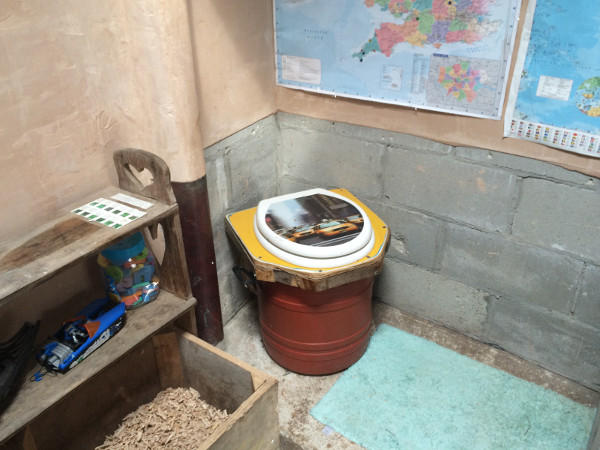
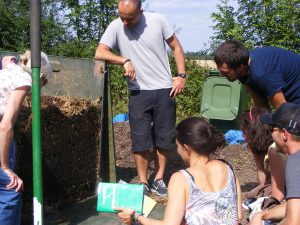
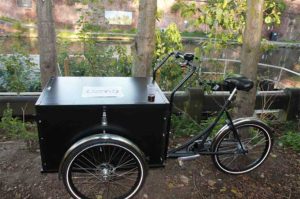
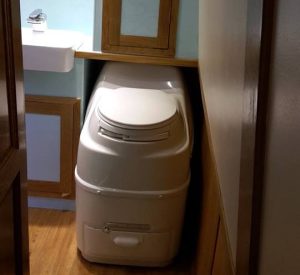

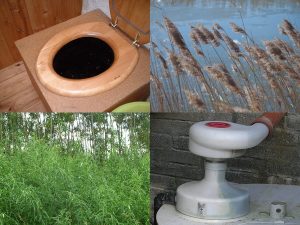

5 Comments
Hi Dave Darby, where did you buy those buckets with lids from?
Anja – not my loo, but I’ll try to get the owner to comment. cheers
We bought them locally at either Macsalvors or Warriors. ?
I’ve been doing this in my city home for the last year. SO far so good. I have a moderately sized carden. Extremely excited about it! 😀 I still hold out for a brave new start-up collecting city dwellers compost buckets weekly & we could have a radical city-wide humanure project happening….
Anyone had any luck sourcing the fisherman’s barrels or similar?